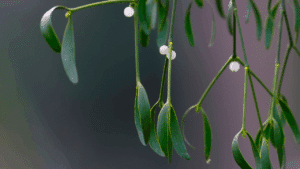
Mistletoe (Viscum album)
Mistletoe (Viscum album) Every Christmas, mistletoe hangs above doorways, inviting

This blog was inspired by our recent CHE Pro Clinical Therapeutics session with Carmen Adamou, who explored the smaller remedies for female pathology.
Helonias is one such smaller remedy; often mistaken for Sepia. Both inhabit the landscape of female exhaustion: the woman who has given too much, who feels emptied or unseen. Yet their inner experiences are profoundly different.

Homeopath and CHE Community Manager
To perceive the distinction requires more than familiarity with their keynotes. It asks that we listen closely to the quality of her depletion: is it the numb disconnection of Sepia, or the weary devotion of Helonias?
Both remedies speak to hormonal imbalance, burnout, and the loss of joy in the feminine sphere; but their direction of collapse, and their path to renewal, diverge completely.
This article explores those nuances: the similarities that make Helonias so easily mistaken for Sepia, and the differences that bring each woman’s story into clear relief.
Both Sepia and Helonias are deeply relevant to female hormonal and reproductive pathology; especially where chronic fatigue, irritability, and pelvic symptoms coexist.
We see overlap in:
At a surface level, both remedies seem to describe the woman who has “lost herself” through overwork, caretaking, or prolonged strain. But the nature of that loss differs, and it’s here that the deeper differentiation lies.
The Sepia state is one of disconnection; from self, from family, from feeling.
Her exhaustion is born from overwhelm and suppression. She has given too much of herself, taken on too much responsibility, and feels emptied out emotionally, hormonally, and spiritually.
The Sepia woman is often stoic; she does what must be done, until she can’t. The collapse is internal: she becomes emotionally flat, intolerant of demands, and resentful of affection.
Her exhaustion is tinged with emptiness and alienation. She withdraws because she cannot feel; she’s lost her connection to her own femininity, her own centre.
“Indifference to loved ones; to occupation, to life itself, yet ameliorated by vigorous movement.”
This paradox; better for exertion, worse for rest, points to the suppressed vitality of Sepia. She must move the body to move the energy.
Physical exertion restores circulation and reconnects her to herself. She runs, cleans, or exercises alone; not to achieve, but to feel alive again.
While Sepia withdraws through disconnection, Helonias collapses through self-neglect.
Her exhaustion is born not of suppression, but of over-devotion.
She is the woman who gives constantly; caring, doing, giving until she forgets her own centre entirely.
Where Sepia is emotionally numb, Helonias is emotionally hungry. She longs for recognition, appreciation, validation. She feels neglected, overlooked, and unappreciated; not resentful, but deeply wounded.
There is a moral tone to Helonias; she feels her worth through usefulness. When her efforts are unseen, she loses joy. Her vitality depends on meaning, on purpose.
And whereas Sepia needs solitude and movement to feel alive again, Helonias needs to be occupied and socially connected. She revives when she is busy in relationship; teaching, caring, interacting, when she feels her actions matter and are witnessed.
In contrast to Sepia’s detachment, Helonias retains warmth. She may feel unappreciated, but she still cares. Her exhaustion is not cold but tender, a tiredness of the heart.
Aspect | Sepia | Helonias |
Source of fatigue | Suppression, over-responsibility, emotional stagnation | Overwork, self-neglect, loss of purpose |
Emotional tone | Indifference, irritability, resentment | Sadness, longing for recognition, devotion |
Relationship to family | Withdraws from husband and children; intolerant of demands | Feels neglected by family; still affectionate |
Mode of renewal | Physical exertion and solitude | Purposeful busyness and social connection |
Amelioration | Exercise, movement, being alone | Work, conversation, being useful to others |
Loss of self | Through disconnection | Through over-identification with duty |
Sense of femininity | Rejected (“feels better away from husband”) | Longing to feel whole, feminine, valued |
Both Sepia and Helonias represent a breakdown in the feminine principle; not in gendered terms, but in the energetic sense of receptivity, nourishment, and connection.
Sepia moves away from herself and others, cutting emotional ties to preserve energy. Her disconnection is a defence.
Helonias moves toward others, seeking connection and affirmation. Her depletion comes from giving too much and asking for too little.
Understanding this polarity transforms how we perceive female exhaustion. Both remedies touch the same terrain; endocrine burnout, uterine congestion, loss of libido, but the inner experience determines the prescription.
Both remedies suit menopausal and post-partum states, where hormonal balance shifts the woman’s sense of self.
Sepia often suits:
Helonias often suits:
Both remedies restore vitality through reconnection; Sepia by reawakening individuality, Helonias by rekindling meaning.
When a woman says, “I feel nothing,” think of Sepia.
When she says, “I do everything, but no one notices,” think of Helonias.
Both are exhausted; but one has turned away from life, while the other yearns to return to it.
As homeopaths, our role is to hear not only the story of depletion, but its direction – whether it moves inward or outward, toward solitude or toward recognition.
The remedies themselves speak to that polarity. One restores the self through boundaries, the other through belonging.
In every woman who presents with exhaustion, hormonal imbalance, or loss of joy, we can listen for this quiet question beneath the case:
“What have I lost connection with; myself, or the meaning of what I do?”
When we discern that, we can see whether the remedy that meets her best is Sepia’s self-reclamation or Helonias’s reawakening of devotion.
And in that distinction lies the art and beauty of homeopathy.
If you found this post helpful, you’ll love what’s waiting for you inside CHE Pro; our professional membership for homeopaths who want to keep growing, learning, and feeling supported in practice.
Whether you’re newly qualified or decades into practice, CHE Pro is your home for ongoing support and brilliant homeopathic education.
We’d love to welcome you in.
Disclaimer
The content shared here is intended for informational purposes only and should not be considered a replacement for professional medical advice, diagnosis, or treatment from a qualified and licensed healthcare provider. The views and opinions expressed in this presentation are those of the presenter and do not necessarily represent those of CHE or any affiliated organizations.

Mistletoe (Viscum album) Every Christmas, mistletoe hangs above doorways, inviting

Your Guide to Calc Tissue Salts Tissue salts, also known

Natrum Muriaticum vs Nitric Acid: When Defensive Minds Look Alike
